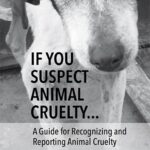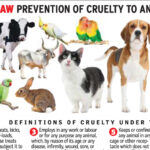Animal cruelty can be succinctly described as a neglectful or malicious action aimed at inflicting unnecessary pain or suffering on an animal. It is a harsh reality that infiltrates various aspects of society, reverberating through culture and ethics. The boundaries of animal cruelty are broad, encompassing both overt violence and insidious neglect. In the labyrinth of this grave issue, understanding what constitutes animal cruelty is essential for cultivating awareness and promoting empathy.
At its core, animal cruelty manifests through two primary forms: active cruelty and passive neglect. Active cruelty is characterized by deliberate acts intended to harm an animal, while passive neglect often stems from a lack of knowledge or resources that leads to an animal’s suffering. The disturbing truth is that both forms often overlap, creating a complex tapestry of actions and inactions that contribute to the plight of numerous creatures. To grasp the full scope of animal cruelty, examining distinct examples and case studies provides illuminating insights.
One of the most heinous examples of active cruelty involves dog fighting, a clandestine practice that has proliferated across many regions. Participants in this grotesque exploitation orchestrate brutal battles, pitting dogs against one another for entertainment and financial gains. Often, these animals endure unspeakable torture and training regimens that strip away their dignity and autonomy. The chilling echoes of growls and yelps serve as a macabre symphony, a haunting reminder of the pain inflicted upon helpless beings. The psychological and physical toll on the dogs involved is staggering, leaving scars that often last a lifetime.
Furthermore, the abhorrent trade in exotic animals showcases another dimension of active cruelty. From the lush jungles of the Amazon to the arid deserts of Africa, poachers relentlessly pursue animals for their skin, bones, and other body parts. This industry not only inflicts deadly harm but untangles delicate ecosystems, threatening biodiversity. The metaphor of a spiderweb under duress is fitting; as one strand is severed, the entire structure weakens and destabilizes. Such cruelty encapsulates a profound disregard for the interconnectedness of life on our planet.
Delving into passive neglect, one can observe alarming patterns within the companion animal sector. Cases of hoarding illustrate the tragic consequences of well-intentioned individuals succumbing to overwhelming circumstances. In these scenarios, animal lovers become overwhelmed, unable to adequately care for numerous pets collected over time. The intention to provide a loving home spirals into devastation, a reality where animals suffer from malnourishment, disease, and unsanitary conditions. Here lies the paradox: love, when unchecked, can morph into cruelty. The cries for help become muffled in an echo chamber of compassion gone astray.
Moreover, factory farming exemplifies passive cruelty on a monumental scale. Picture a factory that churns out a product while disregarding the beings involved in its making. Animals raised for human consumption often endure extraordinary confinement, denied the basic comforts of adequate space, social interaction, and natural behaviors. The life of a pig in a gestation crate, for instance, is devoid of freedom—an existence rooted in torment. These confines suffocate any semblance of an idyllic life, representing a chilling departure from ethical farming practices. The metaphor of a gilded cage becomes chillingly relevant, as it encapsulates the cruel irony of a life seemingly sustained but profoundly impaired.
The impact of animal cruelty is not merely limited to the animal victims; it ripples out to affect human society as well. Numerous studies have established a troubling correlation between animal cruelty and interpersonal violence, suggesting that those who harm animals are often predisposed to perpetrate violence against humans. This sinister connection illuminates the urgency of addressing animal welfare as a pivotal component of a compassionate society. By nurturing a culture of kindness towards all creatures, we foster a tapestry of humanity that binds us together rather than a chasm that tears us apart.
Awareness and education serve as critical tools in the fight against animal cruelty. Grassroots movements and advocacy organizations play an essential role in bringing these issues to the forefront of societal consciousness. Through campaigns that highlight the stark realities of animal suffering, individuals are prompted to reevaluate their habits, choices, and attitudes. The transformative power of knowledge often ignites a passion for change, pushing individuals from complacency to active engagement. As a result, collective action can emerge, heralding a new chapter in the relentless fight for animal welfare.
In summation, understanding what constitutes animal cruelty requires an exploration that transcends simplistic definitions. It is a multifaceted issue with roots in societal values, personal actions, and systemic practices. By acknowledging both active and passive forms of cruelty, we can appreciate the suffering endured by countless animals around the globe. Through relentless advocacy, education, and a commitment to promoting empathy, a more compassionate world can emerge—one where all creatures, great and small, are afforded the dignity they inherently deserve. Protecting animals is not merely an act of kindness; it is a testament to our shared humanity and an unwavering commitment to justice for those without a voice.








